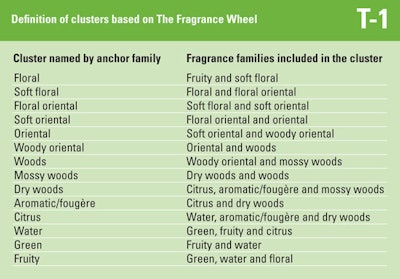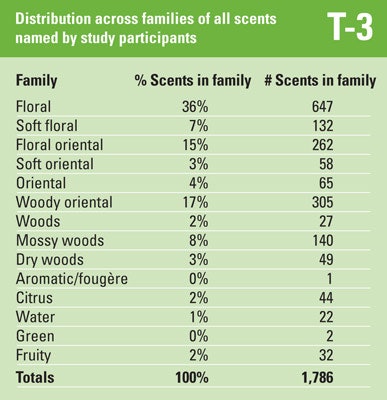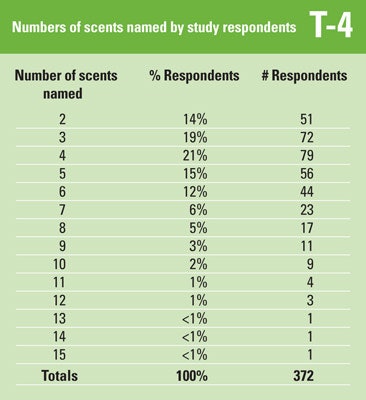This article originally ran in the February 2012 issue of Perfumer & Flavorist magazine. All rights reserved.
Fine fragrance marketing initiatives and sales training continue to ignore the fundamental tie that binds people to their perfume—the olfactory experience of wearing a favorite scent. The fragrance industry continues to dance around the edges of olfactory marketing, but hasn’t gotten religion, investing only half-heartedly in promotional programs based on fragrance families. Sales training and tools have yet to properly harness the power of The Fragrance Wheel and its ability to predict scents that will inspire loyalty and repeat purchases (F-1). New research proves overwhelmingly that women purchase and wear perfume falling into a narrow olfactory range. Isn’t it time for the industry to do a better job connecting consumers to scents they will enjoy?
Fine fragrances belong to categories based on their olfactory characteristics. Research by Manuel Zarzo and David Stanton proved that two-dimensional maps of scent developed from the late 1800s to present are largely consistent.1 Summarized in layman’s terms by this author, Zarzo and Stanton’s research confirms that Michael Edwards’ Fragrance Wheel has earned its place as the gold standard for fine fragrance mapping.2 This wheel is the basis for Edwards’ Fragrances of the World, a comprehensive database and annual guide that allow users to search according to a fragrance of interest and immediately identify others that have much in common from a smell perspective.3 It is also possible to search olfactory categories for commercially available fragrances within them.
Sales Practice, Training and Tools Today
For most readers, the existence of fragrance families is hardly a news flash. Then why aren’t they used more commonly in perfume and cologne marketing? The bottle, packaging and branding contribute in important ways to the relationship between consumers and their scents. Marketers understandably emphasize visuals when promoting fine fragrance. Personality and lifestyle questionnaires are also commonly used to suggest scent purchases. These tests are indirect at best and unreliable at worst in predicting smell preference. In a terrifically crowded fine fragrance marketplace, is it not in the interest of fragrance manufacturers, marketers and retailers to assure that shoppers are better equipped to narrow the field to something they might actually enjoy smelling?
While some retailers have launched consumer-based computer applications and mini-displays of fragrances based directly or loosely on Edwards’ work, the concept of olfactory marketing has not entered sales training and practice in a consistent or meaningful way. In its introductory curriculum, The Fragrance Foundation briefly mentions fragrance families. In more advanced training, the foundation covers the families in somewhat greater depth, but at no time does the curriculum explicitly demonstrate the process for using fragrance families to identify scents customers might enjoy.
Computer-based kiosk applications are available in some stores to promote fragrance sales. Functionality includes attractive content about fine fragrances and supports predictive modeling: “If you like perfume A, you may also enjoy perfumes B and C.” Very well-designed, this type of system even allows for searches based on fragrances of interest to a client, but not necessarily carried by a given store. A robust database supports suggestions for immediately available options sharing an olfactory profile with any scent a user might identify. It is not even necessary for sales associates or clients to understand the concept of fragrance families to perform these searches; options are simply based on the families of scents of interest.
Unfortunately, in the author’s personal experience, in-store training offered to sales staff to encourage use of such an interactive display focuses on branding and personality-based content and system features. This training included no mention of the functionality that allows searching for scents based on fragrance family—what the system calls “type.” While a touch screen option to “find other scents of this type” exists, live training did not mention that option or provide an opportunity for hands-on time to practice searching for scents by family. In the absence of such training, sales staff remain oblivious to the powerful search function, and are unlikely to encourage its use by clients or to use it on their behalf.
Shoppers who want help from a human rather than a touch screen when shopping for fragrance may not get guidance based on their true taste in scent, even when local sales staff has had company-sponsored training. Computer application designers and marketers have overestimated the interest of shoppers in going online with kiosks. Regardless of how attractive kiosk content may be, in-store shoppers prefer to interact directly with beauty products. After all, a rich sensory experience is what motivates consumers to go to the store rather than sitting at home in front of a computer. In-store kiosk use is very low. If the tools are to catch on, enthusiastic handholding for computer-based programs is required. Sales clerks must be more familiar than they are at present with automated tools if they are expected to use these tools and promote their use to clients.
Why the Resistance to Olfactory Marketing?
Though fragrance marketers have spent money on books, databases, in-store displays and computer applications based on fragrance families, they display a lack of conviction that better sales training and consistent use of these tools will cause women and men to buy more fragrance. Why?
The question is especially interesting in the case of stores like Ulta and Sephora, whose merchandising and sales practices are generally brand-agnostic. In these settings, a vast fine fragrance selection creates great opportunities to produce a win for buyer and seller alike. Despite the parent-child relationship between global fragrance giant LVMH and Sephora, for example, the store benefits from any fragrance sale to a client, regardless of the brand.
Is the fragrance industry afraid to reduce the courtship between a fragrance shopper and a scent to something as basic as smell? Would it destroy the mystical seduction of bottle and brand to confront consumers directly with information about how the juice affects their noses?
Can the industry accept that olfactory basics—the differences among floral, oriental, woody and fresh scents and the 14 families comprising them—are intimidating to the uninitiated? Even beauty industry training developers and sales process designers comfortable with the complex features and functions of skin care and color seem to shy away from fragrance families, falling back, instead, on image-based marketing techniques that ignore client preference in scent.
Is it possible that the industry is not yet convinced that individual consumers truly gravitate, over time, to scents sharing an olfactory profile?
The Case for Olfactory Marketing—Individual Loyalty to Fragrance Families
In the face of seemingly irrational dependence upon fragrance marketing that ignores olfactory preference, this author speculated that individual women, over a lifetime, gravitate toward scents reflecting a narrow range of sensory qualities. By the same token, they purchase and wear scents that they like to smell because of their olfactory properties, rather than choosing scents based on aggressive marketing focused on other traits of the product.
Research based on the author’s hypothesis of fragrance family loyalty yielded data patterns significant enough initially to place them within the “too good to be true” range. Statisticians sliced and diced, then diced and sliced the data to ensure that the researcher was not hypnotized by her own hypothesis. The obvious patterns withstood intense scrutiny. Indeed, women have distinct and enduring preferences in scent. Perfumes identified as “ever enjoyed” and “favorite” cluster into olfactory categories reflecting loyalty to scent types over time.
Study Design
The researcher conducted this study as an offshoot of her fragrance consulting practice. From a client base of more than 1,000 women served between 2007 and 2010, she selected 372 to participate in the study. The study design was simple: Respondents identified all of the fragrances “ever enjoyed” and considered to be “favorite” scents. Respondents were encouraged to include the names of scents they may have abandoned for any reason, as long as those scents brought pleasure to them at some time in the past. Study findings are based on women who named at least three scents as “ever enjoyed” and “favorite.”
More than 80% of the interviews took place in a multi-brand retail environment where hundreds of scents were available for testing by respondents. Perfumes eliciting immediate and unqualified positive responses were added to the list of the respondent’s favorites. A critic of this study design might be concerned that any shopper’s quick reaction to a new scent in a retail environment is not a reliable indicator of her taste over a lifetime, since that shopper has not fully experienced the perfume’s heart notes and base notes. In fact, the threshold for inclusion of a scent on each respondent’s list was quite high. Only enthusiastic initial responses to a scent without any hesitation triggered its addition to a list; the researcher was conservative, erring on the side of exclusion, when determining whether to add new scents to individual lists. While the study did not require readiness to buy as a precondition for inclusion, clear preference for new scents was established beyond any reasonable standard.
Fragrances of the World, the authoritative reference for scent classification, was used to anchor the study. In the simplest terms, the research was designed to discover how scents on individual women’s all-time-favorite scents lists clustered into wedges (akin to pie slices of various widths) of The Fragrance Wheel (F-1). The key study facts are as follows:
- Total number of respondents: 372 women participated in the study.
- Total number of entries on “ever enjoyed”/“favorite” lists across all respondents: 1,786 person-to-perfume matches are included in the study database.
- Minimum quantity of scents per respondent: To have their data included in the study, respondents needed to list three or more scents as “ever enjoyed” and “favorite.”
- Unclassified scents: A small number of scents listed were not found in editions of Fragrances of the World published between 2001 and 2010. These may have been long discontinued or obscure scents that were never classified. Fewer than 0.005% of “ever enjoyed” and “favorite” scents were discarded from analysis for this reason.
Slice the Olfactory Pie to Find Out What Perfume She Likes
This study used four related but distinct methods to prove and quantify patterns of olfactory preference among individual women. The methods, explained in detail below, were based on:
- 14 families in The Fragrance Wheel;
- clusters based on the 14 families and defined by the researcher;
- subfamilies of the 14 families defined in the Fragrances of the World database and guidebook; and
- four major categories of scent: floral, oriental, woods and fresh.
Concentration of preference in fragrance families: Fifty-seven percent of all women have half or more of their scents falling into any one family. As an example of how this works, for women naming just three scents as “ever enjoyed” and “favorite,” the half-or-more standard required a full two out of three scents to fall into a single family. For all women in the study, the bar for establishment of concentrated preference (half or more scents in a family) was high, given that there are 14 families in The Fragrance Wheel (F-2).
Concentration of preference in clusters: Ninety-three percent of women in the study had half or more scents identified as “ever enjoyed” and “favorite” falling into a single cluster of families, a concept newly defined by the researcher. These are extraordinarily strong findings with powerful marketing implications.
The rationale for introducing the concept of clusters to this study is as follows: The fact that for well over half of respondents, more than half of the scents identified as “ever enjoyed” and “favorite” fell into a single family among the 14 possible families, as noted earlier, is strong evidence of lifetime olfactory preferences. The reader will recall scientific evidence that adjacencies between families on The Fragrance Wheel are not an arbitrary function of graphic design; rather, proximity on the wheel conveys valid information about olfactory similarity among families.
Given that the wheel represents a legitimate olfactory continuum, how much more might be learned about the strength of olfactory preferences by broadening the definition of categories of scent beyond Michael Edwards’ original 14 fragrance families, grouping them into what are here called clusters? In fact, examination of these clusters magnifies the already strong evidence of olfactory preference on an individual level.
Cluster definitions: The clusters are named according to a single fragrance family that this research refers to as an anchor family. In most cases, clusters consist of three fragrance families from The Fragrance Wheel. Exceptions are the dry woods, citrus, water and fruity clusters, which consist of four rather than three Fragrance Wheel families. Very weak concentration of preference in some families explains the decision to create broader clusters consisting of four families instead of three in some cases. Study respondents named only one aromatic/fougère scent and two green scents. Aromatic/fougère scents are rare for women and green scents are rare generally. To account for the paucity of data in these families, study design allowed next-closest neighbors on The Fragrance Wheel to be considered adjacent to each other in cluster definitions (T-1). An example of how clusters are designed is presented in F-3. The percentage of women with half or more “ever enjoyed”/“favorite” scents in clusters is presented in F-4.
Concentration of Preference in Subfamilies of the 14 Families on The Fragrance Wheel
While The Fragrance Wheel consists of just 14 distinct fragrance families, the Fragrances of the World database and guide contain a more detailed categorization of scents. Within many of the 14 families, scents are further classified by subcategories reflecting fragrance characteristics. Sometimes these characteristics are unique breakdowns within a family and are not one of the 14 families—carnation, honeysuckle and gardenia, for example, are subfamilies within the floral family, but there are no families with corresponding names among the 14 families on The Fragrance Wheel. Sometimes, however, the subfamily breakdowns within a family are the same as a family name—green, for example, is a characteristic of fragrances within the floral family, though green is also the name of one of the 14 families on the wheel.
In order to determine whether women have lifetime preferences in scent that may somehow be missed using families previously defined by The Fragrance Wheel or by clusters defined elsewhere in this research, new groupings were devised based on a hybrid of the 14 families and subcategories thereof.
This new slice of the data showed that fruity and/or citrusy characteristics in commercial fragrances are a key driver of olfactory preference, although the popularity of citrus and fruit is not clearly reflected in data that relies simply on 14 families within The Fragrance Wheel. New groupings also underscored the popularity of floral fragrance aspects abundantly clear elsewhere in the research.
Citrus and fruit—notable notes: Study data revealed that for 41% of women in the study, half or more of their “ever enjoyed” and “favorite” scents were citrusy and/or fruity. The new grouping of data that revealed this finding used a combination of the citrus and fruity families on The Fragrance Wheel and the citrus/fruity subcategory of the following families: dry woods, floral, floral oriental, mossy woods, oriental, soft floral, woods and woody oriental.
Concentration of Preference in Four Major Fragrance Categories
While the four major classifications of floral, oriental, fresh and woods are commonly recognized in the fragrance industry, from a strictly olfactory standpoint they represent distinctions that are crude relative to the 14 families of The Fragrance Wheel. Despite this qualification, readers familiar with the categories may be interested in how the preferences of study participants distribute across floral, oriental, woods and fresh (F-5).
Eighty-six percent of women naming three or more “ever enjoyed”/“favorite” scents showed half or more of their fragrances concentrated in at least one major category. Floral was the most popular category at 54%, followed by oriental at 46%, woods at 5% and fresh at 3%. One quarter of women with major category preferences (half or more “ever enjoyed”/“favorite” scents in any major category) had their preferences evenly split between two major categories. The correspondence of Michael Edwards’ 14 fragrance families to the four categories—floral, oriental, woods and fresh—is displayed in T-2.
Other Study Findings
Popular scents: From the study population of 372 women,the chart in F-6 shows the percentage of women who included scents named most frequently in the study within their list of “ever enjoyed” and “favorite” scents.
Distribution of Person-to-Perfume Matches Across 14 Fragrance Families
Study data for 372 women consisted of 1,786 records of “ever enjoyed” and “favorite” scents, with many scents, of course, being named by multiple women. These records of person-to-perfume matches distribute into the 14 families in The Fragrance Wheel as shown in T-3.
Number of Scents Women Named as “Ever Enjoyed” and “Favorite”
Each woman participating in the study was encouraged to name as many scents as she could remember as “ever enjoyed” and “favorite.” The researcher prodded study subjects for additional scents until it was clear that the respondent would recall no more. The most common number of scents on a woman’s list was four. See T-4 for figures on number of scents named.
Olfactory Preference—Key Driver for Fine Fragrance Sales
Some retailers have attempted to use the Fragrances of the World guide, database and consumer-oriented software as tools in fragrance marketing. Nonetheless, the industry has generally ignored fragrance families in favor of marketing approaches that fail to answer the fundamental question: “What do people want to smell?” Oblivious to the liquid inside, a consumer may acquire a new bottle whose shape, name and advertisements resonate with her sense of self. Eventually, however, she will revert to olfactory type, only wearing and repeating the purchase of scents truly enjoyed.
This study proves that most women, over a lifetime, will develop attachments to perfumes that fall within a specific range on the olfactory continuum. The fragrance industry can improve upon marketing promotions currently based on the equivalent of an olfactory roulette wheel. Aspirational marketing and celebrity endorsements support an initial purchase. To combat consumer fatigue with excessive options and to broaden and deepen the market for perfume, it is necessary to target sales to individuals based on the smells they enjoy.
Acknowledgements
The author would like to thank Michael Edwards for his inspiration and encouragement, and Patrick Harrington of the University of Connecticut Department of Statistics for his skillful analysis of the data.
References
- M Zarzo and DT Stanton, Understanding the underlying dimensions in perfumers’ odor perception space as a basis for developing meaningful odor maps. Attention, Perception and Psychophysics, 71, 225–247 (2009)
- L Donna, Fragrance Perception: Is Everything Relative? Perfum Flavor, 34(12), 26–35 (2009)
- M Edwards, Fragrances of the World: Parfums du Monde 2008, 24th ed, Fragrances of the World, Sidney (2008)














